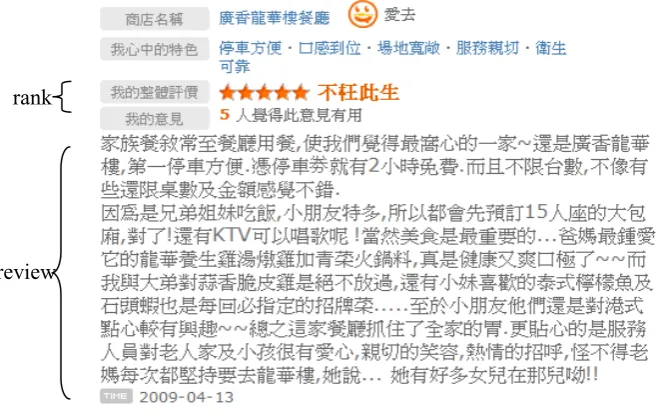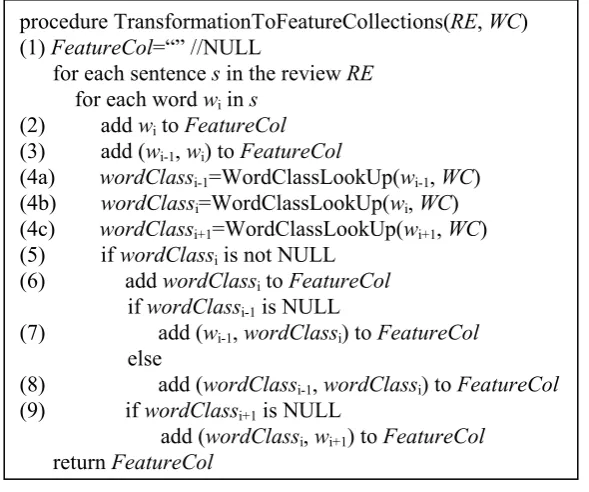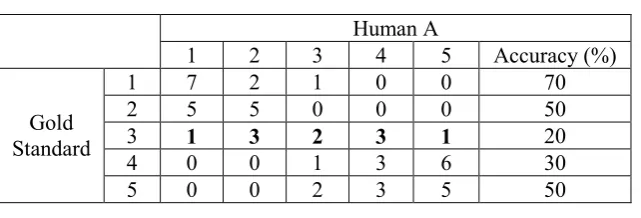reviewers’ attitude toward the service is more positive and with smaller ones meaning reviewers’ experience with the enterprise is more negative. During training, our model leverages machine learning techniques (e.g., maximum entropy or conditional random fields) to estimate associations between various ratings (i.e., one to five) and features, including surface n-gram features and semantic features. Semantic classes of words are exploited in our model in order to alleviate data sparseness problem, which is a serious problem if n-grams of higher degree (e.g., bigrams and trigrams) are employed. We describe our training process in more detail in Section 3.
At run-time, our model firstly transforms a review article into a collection of features and then ranks the review based on the features and the trained machine learning model. Additionally, features may be weighed according to some characteristics such as whether or not the features appear in the first or last sentence of the article and whether or not the features occur in the sentence containing adverbs which are usually indicators of the existence of statements expressing sentiments and often intensify the positive/negative semantic orientation. For example, the adverb “很” (very) in the sentence “人氣 很 高” (it is very popular) means that the restaurant is not just popular, but very popular.
Figure 1: A restaurant review on the Web.
2
Related Work
Recently, various parties have paid a myriad of attention to the research of sentiment analysis for many reasons. Sentiment analysis provides organizations, candidates, political parties and hosts of certain events with the opportunity to automatically identify the subjective remarks toward them or even compile the overall favorability or unfavorability for them. In terms of marketing, damage control, and risk management, it is of great importance.
Some of the research on sentiment analysis focuses on predicting semantic orientations for words (in terms of polarity directions and intensities), especially adjectives, which are good indicators of subjective statements (Hatzivassiloglou and Mckeown, 1997; Hatzivassiloglou and Wiebe, 2000; Wiebe, 2000; Turney and Littman, 2003). Some, however, focuses on identifying the sentiments of collocations (Wiebe et al., 2001), of phrases containing adjectives and adverbs (Turney, 2002), and of phrases marked with polarity (Wilson et al., 2005).
Past research utilizes lexicons (hand crafted in (Huettner and Subasic, 2000) and automatically mined in (Yang et al., 2007a)) or n-gram features (Pang et al., 2002) in automatic
analysis on documents’ sentiments, such as sentiment categorization of reviews or mood classification of Web blogs. The sentiment classification of documents may be approached by first analyzing their sentences’ semantic orientations (Yang et al., 2007b) or sequential sentiments of their sentences (Mao and Lebanon, 2006) or by treating the sentences within as a whole (Mishne, 2005).
In this paper, the goal of our model is to automatically classify reviews into five sentiment ratings using article-level surface n-gram and semantic word-class features. At run-time, we further leverage a simple weighting strategy to give extra weights to features in sentences likely to contain sentiments or evaluative expressions.
3
The Method
3.1
Problem Statement
We focus on ranking review articles using five-star rating scheme. Reviews’ sentiment ratings are returned as the output of the system and can be used as rank suggestion to reviewers. We now formally state the problem that we are addressing.
Problem Statement: We are given a general purpose machine learning model ML (e.g., maximum entropy model), a semantic word-class thesaurus WC (e.g., Chinese synonym thesaurus), and a review article RE. Our goal is to assign the most probable sentiment rating r (r is an integer between one and five) to the review RE via ML. For this, we transform RE into a collection of feasible features, F1, …, Fm, such that the correct rank of RE is likely to be
obtained.
In the rest of this section, we describe our solution to this problem. First, we define a strategy for transforming review articles into collections of features (Section 3.2). These feature collections are then utilized to train a machine learning method regarding the associations between features and different sentiment ratings. Finally, we show how our model rates a review article at run-time by applying highly-tuned rank-feature associations and feature weighting (Section 3.3).
3.2
Learning Rank-Feature Associations
We attempt to find transformations from review articles into effective feature collections that consist of terms (or features) expected to assist in rank determination. Our learning process is shown in Figure 2.
Figure 2: Outline of the process used to train our model.
Preprocessing Review Articles. In the first stage of the learning process (Step (1) in Figure 2), we word segment and PoS tag the review articles in training data. For example, we segment and tag the Chinese restaurant review “好吃又便宜!真棒!值得推薦” as “好吃/VH 又/Db 便宜 /VH !/Fw 真/DFVH 讚/bb !/Fw 值得/VHDb 推薦/VC” (English translation: The food is good and not expensive! Goody! Worth recommending to friends). Moreover, we heuristically divide reviews into “sentences” by using punctuation marks as delimiters. Take the above article for instance. It comprises three sentences: “好吃又便宜!”, “真棒!”, and “值得推薦”. Note that, in these review articles, some Chinese characters are “abbreviated” by their sound-like shorthands. To avoid the possibility of degrading the performance of a Chinese word
segmenter, we replace popularly used shorthands with their corresponding regular form. See Table 1 for examples.
Table 1: Shorthands for some Chinese characters.
Shorthand Regular Form Shorthand Regular Form
ㄌ 了 ㄅ 吧
ㄉ 的 ㄋ 呢
ㄚ 啊 ㄇ 麼
Transformation from Reviews into Features. In the second stage of the training (Step (2) in Figure 2), we transform review articles into collections of features. Figure 3 shows the transformation algorithm.
Figure 3: Transformation algorithm.
In Step (1) of the transformation algorithm we define an empty collection, FeatureCol, for gathering article-level n-gram or semantic word-class features. For each word in the sentences of the given review RE, we include it into FeatureCol as unigram feature (Step (2)). We also consider bigram feature (Step (3)).
In Steps (4a), (4b) and (4c) we look up the (semantic) word classes for words wi-1, wi and
wi+1, and denote them as wordClassi-1, wordClassi and wordClassi+1, respectively. Word class features incorporated into our model aim at alleviating data sparseness problem and reducing out-of-vocabulary encounters at run-time. If there is a word class for wi in the semantic thesaurus WC, it is added into the feature collection (Steps (5) and (6)), referred to as class-based unigram feature, CBuni for short. On the other hand, we deal with the class-based bigram feature, CBbi for short, from Step (7) to (9). Compared to the surface bigram features in Step (3), the semantic class-based bigrams are not necessary bigrams of word classes. Words can be included in the class-based bigram features if one of their adjacent words can be labeled with semantic classes. (Steps (7) and (9)). In the end, this procedure returns the feature collection of the review article.
procedure TransformationToFeatureCollections(RE, WC) (1) FeatureCol=“” //NULL
for each sentence s in the review RE for each word wi in s
(2) add wi to FeatureCol (3) add (wi-1, wi) to FeatureCol
(4a) wordClassi-1=WordClassLookUp(wi-1, WC) (4b) wordClassi=WordClassLookUp(wi, WC) (4c) wordClassi+1=WordClassLookUp(wi+1, WC) (5) if wordClassi is not NULL
(6) add wordClassi to FeatureCol if wordClassi-1 is NULL
(7) add (wi-1, wordClassi) to FeatureCol else
(8) add (wordClassi-1, wordClassi) to FeatureCol (9) if wordClassi+1 is NULL
(words or phrases) resulting mostly from human’s subjective judgement makes it hard to find an accurate classifier.
Table 2: Results of human annotators.
Accuracy (%)
Human A 44
Human B 46
In experiments, to inspect the performance of our model, a test data set, made up of 5,000 restaurant reviews, was allocated. Since testing data were uniformly distributed among sentiment ratings, the expected precision of random guessing was 20%. Table 3 shows the accuracy of our MaxEnt baseline using surface n-gram features (Note that using feature presence, instead of feature frequency, (see Eq 2 in Section 3.2) did not improve the accuracy of our baseline). As we can see, our MaxEnt baseline achieved comparable results with humans’ (see Table 2). In Table 3, the result of conditional random fields4 (CRFs) fed with the same features is listed for comparison. Although there was a noticeable difference between the performances of two machine learning techniques, these two substantially outperformed the method of random guessing.
Table 3: Results of different machine learning techniques.
Accuracy (%)
CRFs 36.56
Baseline 45.18
Table 4 summarizes the performance of our model using class-based unigram (CBuni) or class-based bigram (CBbi) features. In Table 4, we find that our model benefited from using higher-degree class-based n-grams ((3) vs. (2)), and that our model with semantic unigram and bigram features improved approximately 1% over the baseline ((3) vs. (1)), suggesting the baseline probably suffered from data sparseness problem in that it only took surface word forms into account.
Table 4: Performance on semantic features.
Accuracy (%)
Baseline (1) 45.18
+CBuni (2) 45.82 +CBuni+CBbi (3) 46.14
On top of n-gram and semantic features, we conducted experiments where, at run-time, features of sentences belonging to firstS, lastS, and advS received larger weights. As suggested in Table 5, replicating features in sentences with adverbs worked better than replicating those in the first and last sentences of reviews. Although doubling features of sentences falling into the categories of firstS and lastS was not as effective as expected, it might not mean these sentences should not be taken more seriously, but might mean we need a more sophisticated run-time weighting strategy, instead. Encouragingly, giving more weights to sentences containing adverbs by means of replicating their n-gram and semantic features boosted the precision to 46.34, achieving a relative gain of 2.5% over the strong MaxEnt baseline.
4
Table 5: Performance on different run-time weighting mechanisms.
Accuracy (%)
firstS 45.56
lastS 45.62
advS 46.34
On the other hand, our model may be used to provide a list of rank suggestion for a review. As such, we leveraged mean reciprocal rank (MRR), the average of the inverse of the rank of the
first correct answer, to measure the suggestion quality of our model. The MRR of our best model (i.e., baseline+CBuni+CBbi+advS) was 0.6849, indicating that, most of the time, the first and the second sentiment ratings on our suggestion lists would be adopted by review authors.
4.3
Discussion
To analyze errors our system made, we examine the confusion matrix, shown in Table 6, on our testing data. A confusion matrix lists system’s results with respect to the gold standard. Take 266 (the bold-faced number in Table 6) for example. It is the number of reviews that were wrongly labeled to 2 by our system, but were labeled to 1 by the authors (i.e., the gold standard). Additionally, the accuracy of our system concerning each semantic rating is also shown (the last column).
As suggested by Table 6, it was not easy for the model to distinguish restaurant reviews between rank 1 and rank 2 and ones between rank 4 and rank 5. The reason is probably because maximum entropy model, our system bases on, does not “understand” that there are strength differences among semantic ratings from one to five. One possible way to avoid this problem is to utilize multi-level classifiers. For example, a top-level classifier first categorizes reviews into negative, neutral, and positive ones. Negative- and positive-labeled reviews are subsequently classified into very negative and negative ones and positive and very positive ones respectively.
Table 6: Confusion matrix of our best system (baseline+CBuni+CBbi+advS).
Our System
1 2 3 4 5 Accuracy (%)
1 488 266 121 35 90 48.80
2 274 410 242 31 43 41.00
3 96 194 472 135 103 47.20
4 28 29 146 306 491 30.60
Gold Standard
5 52 28 79 200 641 64.10
Turney, P. D. 2002. Thumbs up or Thumbs down? Semantic Orientation Applied to Unsupervised Classification of Reviews. Proceedings of the Annual Meeting of the ACL, 417-424.
Turney, P. D. and M. Littman. 2003. Measuring Praise and Criticism: Inference of Semantic Orientation from Association. ACM Transactions on Information System, 21(4).
Wiebe, J. M. 2000. Learning Subjective Adjectives from Corpora. Proceedings of National Conference on Artificial Intelligence.
Wiebe, J. M., T. Wilson and M. Bell. 2001. Identifying Collocations for Recognizing Opinions
Proceedings of the Annual Meeting of the ACL / European Association of Computational Linguistics Workshop on Collocation.
Wilson, T., J. M. Wiebe and P. Hoffmann. 2005. Recognizing Contextual Polarity in Phrase-Level Sentiment Analysis. Proceedings of the Conference on Empirical Methods in Natural Language Processing, 347-354.
Yang, C., K. H.-Y. Lin and H.-H. Chen. 2007a. Building Emotion Lexicon from Weblog Corpora. Proceedings of the Annual Meeting of the Association of Computational Linguistics, 133-136.




